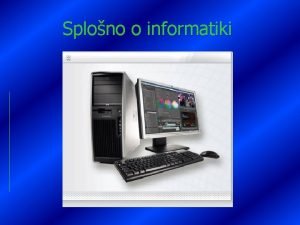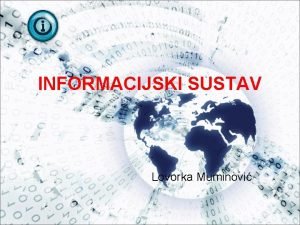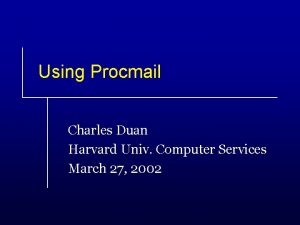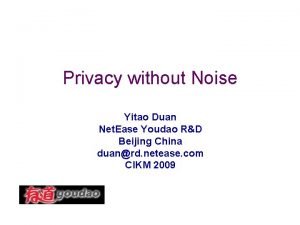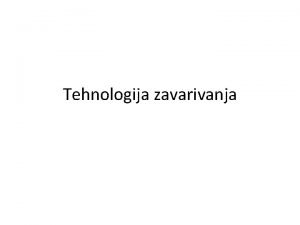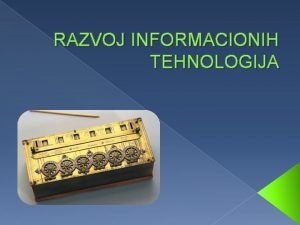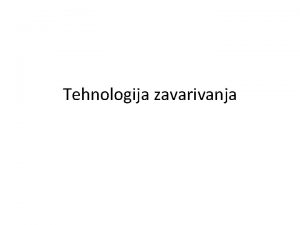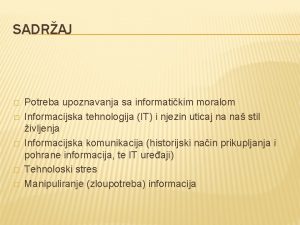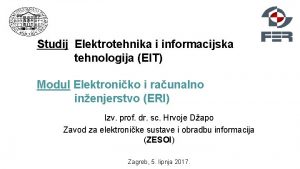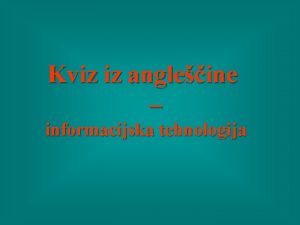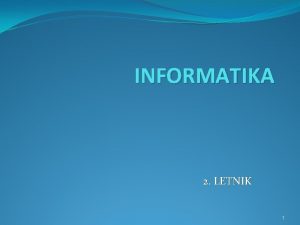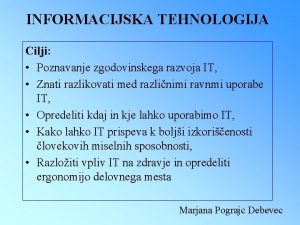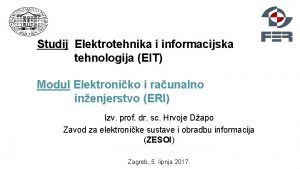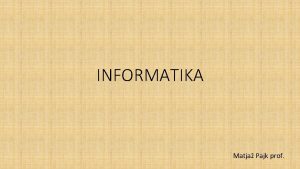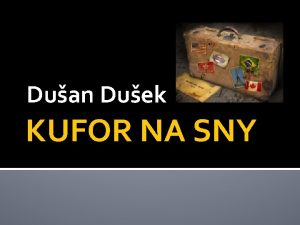Duan Dular Krka d d Informacijska tehnologija in














- Slides: 14

Dušan Dular , Krka d. d. Informacijska tehnologija in elektronsko poslovanje - problemi vzpostavljanja Definicija elektronskega poslovanja (Gartner Group): “The continuous optimization of an organization’s value proposition and value-chain position through the adoption of digital technology and the use of the Internet as the primary communications medium. ”

Zakaj E-poslovanje ? - ogroženost - priložnosti Problemi: Osnovni problemi so predvsem organizacijski ne tehnološki.

Kaj vpliva na intenzivnost uvajanja E-poslovanja? 1. Konkurenca ( smo ogroženi ? ) 2. Vrsta dejavnosti (proizvodnja, trgovina, usluge. . ) 3. Stopnja razvitosti podjetja (organizacijska, informacijska, kulturna) 4. Stopnja razvitosti okolja podjetja ·države (infrastrukture, zakonodaje) ·potrošnikov ·kupcev in dobaviteljev 5. Inf. tehnologija ( vidimo priložnosti ? )

Pogoji (ovire) za uspešno uvedbo E – poslovanja: 1. CEO za E – poslovanje 2. Urejenost informacijskih sistemov (predvsem problem ustreznosti in povezanosti IS v podjetju) 3. Optimizacija materialnega poslovanja in optimizacija preskrbovalne verige 4. Določitev proritet po področjih -reklama -promocija -končni potrošnik -poslovanje s kupci -poslovanje z dobavitelji

5. Informacijske tehnologije Internet je osnova, toda brez ostalega ne gre: -MQ ( prenosi podatkov) -EDI, XML ( povezave s partnerji) -JAVA ( Internet aplikacije) -sporočilni sistemi, -dokumentacijski sistemi -…. . .

Težave (dileme) : - prioritete – zaostanki so ovira - v izboru ( je novo boljše od starega, vse večji izbor, izkoriščenost ) - kdaj uvesti ( stabilnost produktov) - v uvajanju - znanje (pre)hitro stari - dostopnost znanja ( lokacija, cena)

Pa vendar: Vse težave z IT so premagljive, če imamo jasen poslovni cilj.



Integracija aplikacij - do leta 2002 Internet-based B 2 B and B 2 C e-business applications will be the largest single motivation for implementing closeknit, real-time A 2 A integration through 2002 (0. 8 probability). Supply chain management stretches B 2 B and A 2 A integration to the limit because it involves so many semi-autonomous participants — including customers, suppliers, carriers, agents, warehouse operators, forwarders and consolidators.

Users should consider applying ZLE to business problems where: 1) conditions change quickly; 2) fresh information is more valuable than stale information; and 3) the business problem involves the participation of multiple interdependent business units and multiple application systems. Internet-based B 2 B and B 2 C e-business applications will be the largest single motivation for implementing close-knit, real -time A 2 A integration through 2002 (0. 8 probability).

Supply chain management stretches B 2 B and A 2 A integration to the limit because it involves so many semi-autonomous participants — including customers, suppliers, carriers, agents, warehouse operators, forwarders and consolidators. ZLE and STP strategies are changing some batch steps into realtime interactions, but more than half of all integration will still involve batch transfers through 2004 (0. 9 probability). Through 2004, 70 percent of the enterprises that assign the responsibility for organizing application integration to a central team will have effective integration; 70 percent of those that leave all responsibility for integration with the individual application groups will be judged unsatisfactory by their senior management (0. 8 probability).

Enterprises that integrate business-to-business and business-toconsumer technology infrastructures by year-end 2002 will gain a 25 percent to 50 percent competitive advantage over enterprises that manage the technologies separately (0. 7 probability). By 2002, 80 percent of new AD initiatives will be built with a combination of C++, Visual Basic, and Java language skills and technologies (0. 7 probability).

 Kaj je informacijska tehnologija
Kaj je informacijska tehnologija Krka monastery
Krka monastery Muminovi
Muminovi Nacionalni park krka prezentacija
Nacionalni park krka prezentacija Charles duan
Charles duan Zhiyao duan
Zhiyao duan Yitao duan
Yitao duan Jiali duan
Jiali duan Lingjie duan
Lingjie duan Tehnologija zavarivanja
Tehnologija zavarivanja Razvoj informacionih tehnologija
Razvoj informacionih tehnologija Zelena tehnologija
Zelena tehnologija Tehnologija mleka
Tehnologija mleka Mag zavarivanje gasa
Mag zavarivanje gasa Elektrotehnicar informacionih tehnologija predmeti
Elektrotehnicar informacionih tehnologija predmeti
